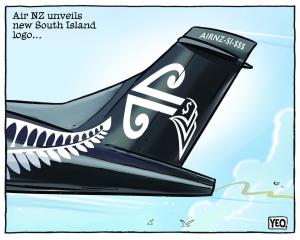"The entire New Zealand army," James quipped.
While the jest was obviously a massive exaggeration, New Zealand's defences forces have a long history of being undermanned and underarmed.
To that, unfortunately, can be added bumbling and bungling procurement.
While the air force's lack of strike-force capability remains a joke, significant expense and effort has gone towards better equipping the navy and army - only for poor judgements and decision-making to undermine much of the progress.
What remains of the air force has also had it share of problems.
How appropriate it was that the navy's new patrol vessel, HMNZS Otago, developed faults in both engines at the same time during sea trials off Australia last month.
That sums up the debacle that has been the navy's $500 million Project Protector programme, with the building of seven ships uncovering a flotilla of faults and failings.
It certainly looks as though the navy would have been much wiser to have bought tried and tested vessels rather than playing politics with Australia and Whangarei and having ships constructed in Melbourne and Northland.
HMNZS Canterbury, the multi-role ship in this little fleet, had so many defects that manufacturer BAE Systems paid the Government $84.6 million to repair them.
A scathing independent review last year said the ship's poor performance in high seas would now just have to be accepted.
The project lacked outside oversight and the complexity and challenges of Project Protector were underestimated in all respects.
Otago and its sister ship Wellington, the two offshore patrol vessels, may also not entirely be fit for purpose.
Otago was due in operational service as long ago as mid to late 2007.
One trusts its weight and other issues are all but sorted, and it has the required ability to patrol effectively in Antarctic ice as well as in rough seas.
The engine faults that forced it back to Melbourne were just the latest in a litany of shortcomings that reflect badly on all those involved.
It was not as if the navy already had a passable record of ship purchases, having already made of mess of buying the troop transporter Charles Upham in 1994.
The "lemon ship", as it came to be known, cost $21 million and another $35 million would have been required to fix all its problems.
It was sold to a Spanish company for $8 million to carry citrus fruit.
How disappointing that one of the army's latest purchases did its best to outdo the worst of the navy's larks.
The army spent $590,000 on bullets that were unfit for use in the army's guns, and had to resell the ammunition for $350,000.
Not to be outdone in magnitude of waste, the army's light operational vehicles were 63 months late, cost $37 million more than planned and had a string of difficulties.
Now the Government is looking at selling 35 of the 105 because it believes too many were bought.
The air force, meanwhile, faces indefinite delays in the upgrade project on its Hercules transport aircraft, costing 100 jobs in Blenheim, and Orion navigation and sensor upgrades worth hundreds of millions of dollars are years overdue.
Although the occasional blunder in matters so complex is understandable, and perhaps inevitable, the Defence Force's record is appalling.
Questions must be asked about the particular calibre of those making the decisions and the culture that appears to promote squandering of resources.
Is this also another example of slackness and insufficient accountability so common with public money? The Defence Force does need to be properly equipped as we pay our long-term insurance policies in a big and potentially very bad world. But it is little wonder the Government in March announced a "value for money" inquiry into the Defence Force, led by former Telecom chief executive Roderick Deane, as better bang is sought for taxpayers' bucks.
That, however, seems unlikely of itself to prevent further procurement mistakes.
One shudders at how Clive James could have mocked the botch-ups of the past and those still to come.












